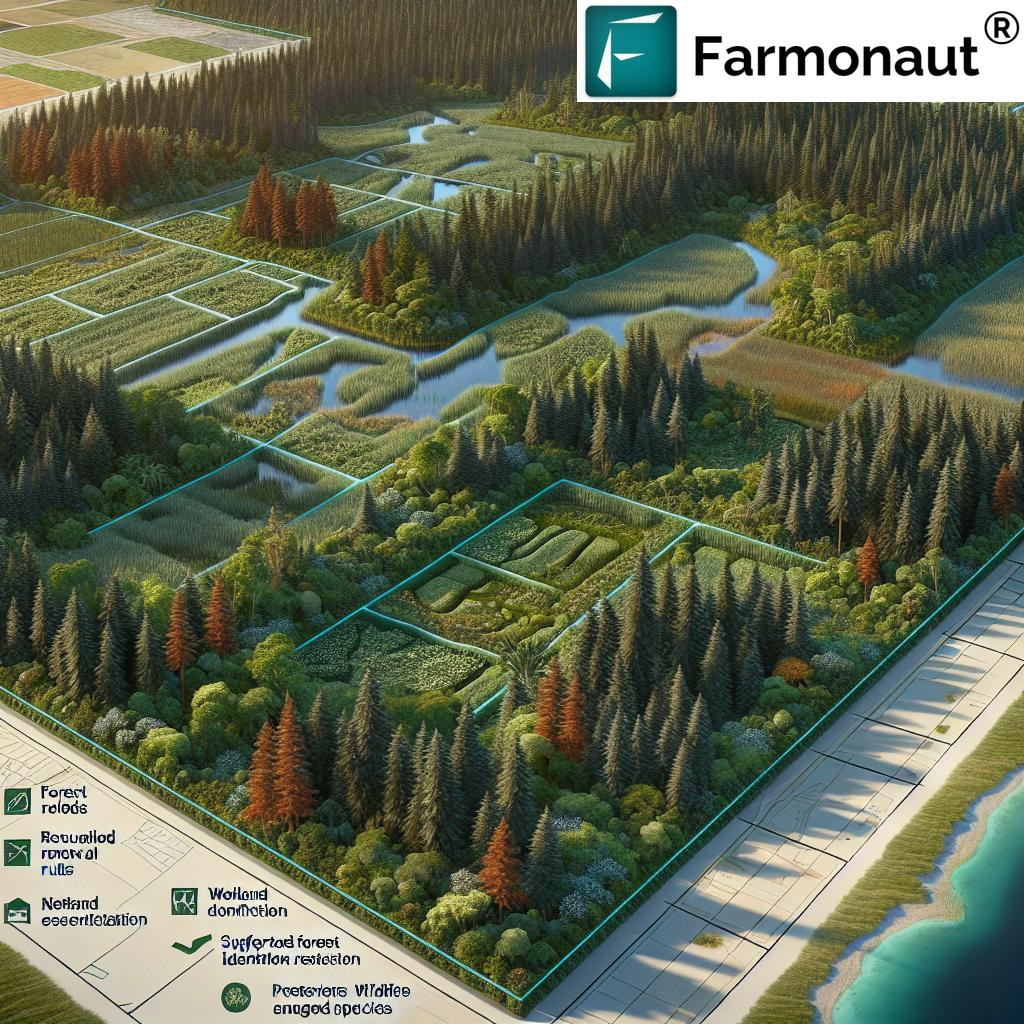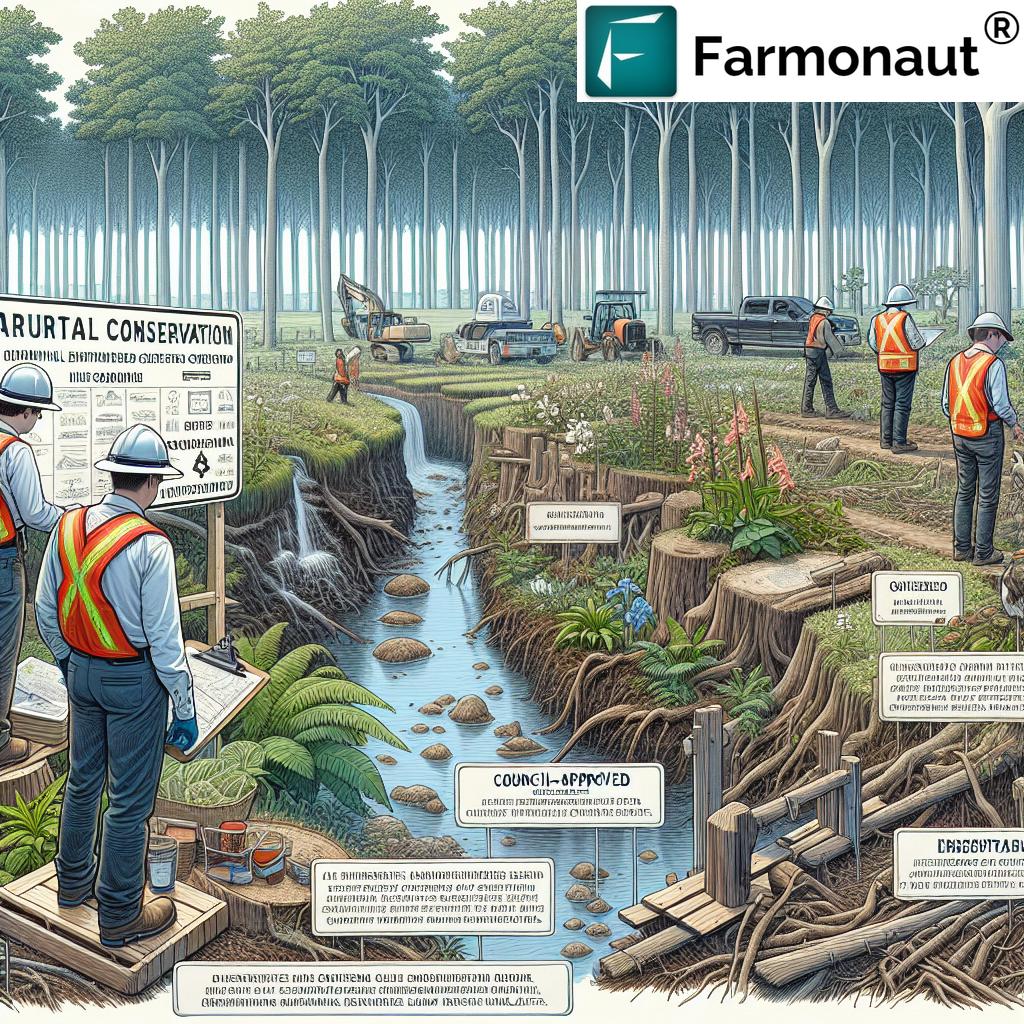Woodland Removal Regulations: 5 Key Impacts in Simcoe County
Table of Contents
- Introduction to Woodland Removal and Forest Conservation in Ontario
- Simcoe County: The Heart of Ontario’s Woodland Debate
- Woodland Removal Regulations: Provincial, County, and Township Policies
- Woodland Removal: Site Inspection and Environmental Impact Study Requirements
- 5 Key Impacts of Woodland Removal in Simcoe County
- Comparative Impacts Table
- Advanced Technologies for Woodland and Agricultural Management
- Farmonaut: Empowering Woodland and Agriculture Sustainability
- Frequently Asked Questions
- Conclusion: Striking a Sustainable Balance
Introduction to Woodland Removal and Forest Conservation in Ontario
In Ontario, woodland removal is a topic at the intersection of sustainability and productive land use. Forest conservation in Ontario is governed by a patchwork of provincial, county, and municipal regulations to manage the delicate balance between expanding agricultural acreage and protecting critical habitats, especially those supporting endangered species.
As Simcoe County continues to grow, both in population and agricultural demands, the way we address woodland removal regulations reflects our values about land use, biodiversity, and food security. Here, we explore the rules, procedures, and, crucially, the 5 key impacts of woodland removal on our local environment and future.
Simcoe County: The Heart of Ontario’s Woodland Debate
Simcoe County lies at the centre of Ontario’s tension between expanding agricultural land and forest conservation. The county’s commitment to sustainable development, rural community identity, and ecosystem health is challenged whenever large woodlands are proposed for removal.
In Springwater Township, councillors recently approved a significant woodland removal exemption to increase productive acreage. Here, we witness direct impacts on endangered species habitat protection, wetland mapping and identification procedures, and hardwood forest management.
Woodland Removal Regulations: Provincial, County, and Township Policies
To understand recent decisions in Springwater and across Simcoe County, we must grasp the underlying woodland removal regulations and forest conservation in Ontario:
- Ontario Forestry Legislation & Conservation Acts: The Forestry Act, Endangered Species Act, and linked environmental regulations set out provincial requirements for woodland, wildlife, and habitat conservation. The acts define what constitutes a protected woodland area and outline the need for authorization before removal or alteration, especially where endangered species or significant wetlands are present.
- County Bylaws & Protected Woodland Exemption Rules: Counties (like Simcoe) and municipalities pass their own bylaws controlling woodland removal, exemptions for agricultural expansion, and penalties for unlawful clearing. The bylaw may require site inspections, environmental impact studies, or species-specific management.
- Planning and Zoning Considerations: Land use plans identify which areas are designated agricultural, which areas are protected woodland, and how conflicts are mediated. The Nottawasaga Valley Conservation Authority (NVCA) provides vital input on regulated wetland mapping and function assessment to ensure development or tree removal doesn’t harm sensitive zones.
Authorization from the provincial Ministry of Environment, Conservation and Parks (MECP), or in some cases, only a review and site inspection by county forestry staff, are needed before a protected woodland area is altered.
Woodland Removal: Site Inspection and Environmental Impact Study Requirements
When an application to remove woodland is submitted, county and often provincial agencies step in for site inspection for property development. These inspections are critical to:
- Verify mapping accuracy: Confirm woodland, wetland, and habitat features using ground truthing compared to existing wetland mapping and identification systems.
- Assess forest quality: Identify mature native hardwood trees, conifer species proportions, and stand health.
- Identify endangered species habitat: Locate features or zones used by protected plants or wildlife, triggering additional habitat protection rules under the Endangered Species Act.
- Determine environmental impact study requirements: Decide if a full environmental impact study (EIS) is needed to evaluate wetland function or species impact. In the recent Springwater case, staff concluded that wetlands identified on maps were wrongly classified, negating the need for an EIS but confirming endangered species presence requiring special buffers or removal timing.
5 Key Impacts of Woodland Removal in Simcoe County
Let us walk through the core consequences when exemptions for woodland removal are granted in Simcoe:
1. Biodiversity Loss and Endangered Species Habitat Protection
Every lost woodland area represents a loss of habitat for flora and fauna, with certain woodlands serving as the last remaining refuges for endangered species. In Simcoe County, more than 30 endangered species rely on these forests—meaning habitat loss directly jeopardizes their survival.
- Legislation: Ontario’s Endangered Species Act requires habitat assessment and, if necessary, habitat-specific conditions or timing restrictions for woodland clearing activities. Conditional exemptions are possible with mitigation (e.g., leaving habitat buffers or clearing outside breeding seasons).
- Impact: Long-term losses in biodiversity; disrupted migration or breeding cycles; increased species at risk due to fragmented or non-contiguous habitats.
2. Water Quality and Wetland Functions
Woodlands adjacent to mapped or unmapped wetlands contribute to natural water filtration, flood attenuation, and hydrologic cycle support. Losing woodland cover near water systems—even when direct wetland features are not present—may degrade water quality, increase runoff, and magnify flood risks downstream.
- Mapping: In Simcoe, the NVCA uses wetland mapping and identification to guide clearing exemption approvals and recommend buffer zones.
- Impact: Reduced water quality, increased pollutant loading in streams, and potentially compromised wetland functions even if not officially identified as such during the site inspection.
3. Soil Erosion and Land Stability
The removal of mature native hardwood trees and conifers increases vulnerability to soil erosion, diminishes organic matter inputs, and alters microclimates. Loss of forest cover can also destabilize slopes and increase the likelihood of sedimentation in nearby waterways.
- Regulation: Forest conservation in Ontario and Simcoe’s woodland bylaws often require restoration or soil erosion management plans when authorizing removals.
- Impact: Persistently higher rates of soil loss, necessitating expensive remediation; potential downstream impacts on aquatic habitats.
4. Agricultural Expansion and Resource Efficiency
Most woodland removal applications in Simcoe County, including the 16-hectare Springwater case, are justified on the grounds of enhancing productive acreage and making agricultural operations more efficient. While this can increase food production and farm revenues, it must be weighed against irreversible ecological losses.
- Authorization: Exemptions for agricultural expansion are generally only granted if the site inspection and planning documents show the benefits cannot be achieved otherwise, and all conservation requirements are addressed.
- Impact: Increased local food and crop output; potential improved farm economic stability; but with sustainability concerns.
5. Long-Term Land Use and Development Pressures
Approving woodland removals for agricultural purposes may pave the way for further planning and development changes in the future, especially if the property is eventually redesignated from agricultural use to development purposes. This interplay between current policy and uncertain future land use can fragment forests and lead to cumulative environmental impacts.
- Regulations: County and township plans seek to anticipate these pressures by tracking cumulative woodland loss and adjusting policy as needed.
- Impact: Gradual decline in overall forest cover; increased urbanization or rural sprawl; policy lag in responding to land use shifts.
Comparative Impacts of Woodland Removal in Simcoe County
| Impact Category | Description of Impact | Estimated Affected Area (ha/year) | Potential Long-Term Effect | Relevant Regulation / Policy Reference |
|---|---|---|---|---|
| Biodiversity Loss | Loss of habitat for endemic and endangered flora/fauna in valuable woodland areas. | ~100 ha | Decreased species richness; more local extinctions over 10-30 years | Ontario Endangered Species Act, County Woodland Bylaws |
| Water Quality | Alteration of hydrology and increased runoff reduces quality in surface water and wetlands. | ~70 ha (adjacent to water bodies) | Elevated nutrient/sediment loading for 5-20 years post-removal | NVCA Guidelines, Provincial Planning Act |
| Soil Erosion | Reduced root mass and canopy cover exposes soil, increasing erosion risk. | Up to 60 ha | Loss of soil fertility, reduced productivity within 3-10 years | Forest Conservation By-law, Soil Conservation Act |
| Endangered Species Habitat | Specific removal may eliminate unique species features or breeding areas. | 30+ ha (core habitats) | Permanent local declines in species at risk | Endangered Species Act, Environmental Impact Study Requirements |
| Agricultural Expansion | Increase in total productive farmland but at ecosystem cost. | Up to 100 ha/year (countywide) | Improved yields & revenues; loss of long-term ecosystem services | Planning Act, County Development Plans |
Advanced Technologies for Woodland and Agricultural Management
Remote sensing, AI-driven advisory, and real-time environmental monitoring are transforming how we approach woodland removal regulations, forest conservation in Ontario, and agricultural land expansion. With Farmonaut, these technologies become accessible tools for:
- Satellite-based woodland & crop monitoring for site planning, mapping, and compliance tracking. By using multispectral satellite imagery, farmers and planners can accurately assess vegetation health, track mature native hardwood and conifer tree status, and spot unauthorized removals or health declines.
- Blockchain-based traceability to record and verify all land use changes, part of the Farmonaut Product Traceability Solution. This improves supply chain credibility and supports conservation compliance.
- AI-powered habitat mapping for efficient identification of endangered species features and at-risk habitats, ensuring compliance with environmental impact study requirements and supporting sustainable development.
- Carbon Footprinting to assess the greenhouse gas impact of woodland removal versus preservation or new forest management, supporting sustainability goals and climate-smart agriculture programs. See the Farmonaut Carbon Footprinting Tool for more details.
- Fleet and Resource Management for agriculture and forestry, optimizing machinery and resource use after land conversion and supporting regulatory reporting. Learn more about Fleet Management Solutions.
These solutions not only help farmers and forestry companies comply with woodland removal regulations, but also ensure long-term operational efficiency, sustainability, and transparency.
Farmonaut: Empowering Woodland and Agriculture Sustainability
At Farmonaut, our mission is to make precision agriculture and woodland management accessible and affordable for all. Here’s how our platform delivers value across the woodland-to-field transition:
- Intuitive mapping and compliance: With large scale farm management and plantation tracking via web and mobile apps, Simcoe County farmers, planners, and environmental professionals can easily map woodland areas, identify regulated zones, and plan for sustainable growth while ensuring all rules are addressed.
- Resource optimization: Farmonaut’s AI-driven advisory system supports efficient land use, from site inspection data crunching to daily weather tracking, soil moisture analysis, and operational alerts.
- Transparency in transitions: Our blockchain-based traceability ensures all stages of woodland removal, agricultural expansion, and subsequent production are securely logged and verifiable.
- Environmental stewardship: By integrating carbon footprint analysis, real-time crop monitoring, and biodiversity tracking, Farmonaut directly supports legislation and conservation compliance.
If you’re interested in leveraging the latest technologies for woodland removal regulations compliance, sustainable growth, or precision forestry, explore Farmonaut Now.
Access Farmonaut’s API or review our API Developer Docs to integrate leading-edge satellite and environmental datasets into your woodland and agricultural planning projects.
For dedicated woodland and forest advice, our Crop, Plantation & Forest Advisory App offers actionable insights on land management, compliance, and conservation.
Frequently Asked Questions (FAQ)
What are the main regulations governing woodland removal in Simcoe County?
Simcoe County follows the Ontario Forestry Act, Endangered Species Act, and county-specific woodland conservation bylaws. These laws require site inspections, mapping confirmation, and, where needed, environmental impact studies. Exemptions are considered only if conditions related to endangered species, protected habitats, and wetland functions are properly addressed.
Does woodland removal always require an Environmental Impact Study (EIS)?
Not always. If site inspections and wetland mapping and identification find no significant wetland or habitat features, and if woodland clearing can occur outside sensitive periods, an EIS might not be needed. However, where there’s potential for habitat loss or uncertain impacts, an EIS is recommended.
How are endangered species protected during tree or woodland removal?
Endangered species habitat protection typically requires either timing restrictions (so no clearing occurs during breeding or nesting periods), physical buffer zones, or special authorization from the Ministry of Environment, Conservation and Parks if direct removal of habitat or species is unavoidable.
Can woodland removed for agricultural purposes later be used for residential or commercial development?
In principle, any change in designation—from agricultural to development—requires a new planning and zoning approval process. However, history shows that initial agricultural expansion may sometimes precede eventual development, increasing the importance of cumulative impact tracking and preventative conservation policies.
How does Farmonaut help with woodland removal compliance and forest conservation?
Farmonaut provides real-time satellite monitoring, boundary and habitat mapping, carbon footprint tools, and traceability solutions. Planners, farmers, and conservationists use these resources for planning, compliance, and sustainable agriculture transition.
How does woodland removal affect soil erosion and water quality over time?
Removing woodland, especially on sloped or hydrologically important sites, generally increases soil erosion rates and degrades water quality due to higher runoff, sedimentation, and nutrient loading. This underscores the role of conservation bylaws, buffer zones, and sustainable land management practices.
Conclusion: Striking a Sustainable Balance
Woodland removal regulations in Simcoe County represent a microcosm of the challenges faced throughout Ontario. Balancing our growing need for agricultural expansion with environmental conservation and endangered species habitat protection is not simple—but it is essential for resilient communities and ecosystems.
Modern advances, especially those offered by Farmonaut, make it possible to plan, monitor, and manage woodland transitions with a precision and transparency that serves both landowners and future generations. The future of Simcoe’s forests and farms depends on our ability to respect, adapt, and innovate within this evolving landscape.
For more on how technology, regulation, and stewardship can converge for smarter land use, try Farmonaut today—and join us in leading Ontario’s agricultural and environmental transformation.


















